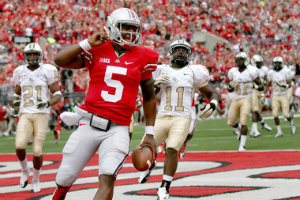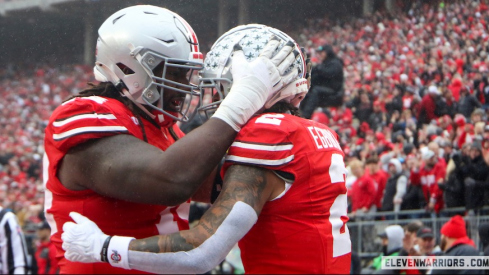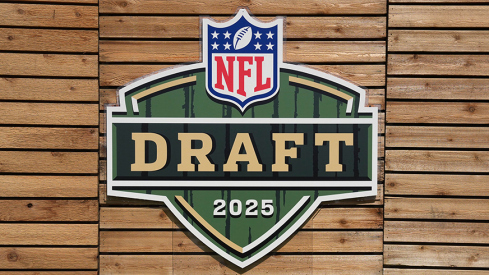While the overall game was far sloppier than we'd like, the good news is that the Buckeyes showed that last week wasn't entirely a fluke performance against a lousy opponent, as UCF is a solid team.
 Can you hear it? Another Braxton TD.
Can you hear it? Another Braxton TD. It's hard to say exactly how good Miami and UCF are this early in the season (just as it's hard to get a complete read on Ohio State this early), but you have to be happy with Braxton's legs, the wide receivers, Corey Linsley, and Ohrian Johnson today.
On the flip side, there's plenty for Meyer to practice this week: penalties, ball control, tackling (CJ Barnett and angles, Christian Bryant) defensive line pressure, coverages in the secondary, and backup running backs come to mind.
Offense
The offense couldn't quite match the 538-yard effort from last week, even with Braxton completing four more passes on the same number of attempts.
| 1D% | 3D% | 4D% | YARDS | passing | rushing | turnovers | penalties | Quickstrike | Sacks | |
|---|---|---|---|---|---|---|---|---|---|---|
| vs. UCF | 25 (52) | 50% | 50% | 411 (949) | 155 (399) | 256 (550) | 3 (3) | 10-79 (13-99) | .413 (.543) | 1 (5) |
Looking at the basic team offense statistics, it's easy to see where the blame might lie: turnovers and penalties. After the game Urban Meyer was quoted as saying:
“Pick your poison,” he said. "Turnovers and penalties. You can't win. That's not a good team.”
After not turning the ball over once against Miami, the offense had two fumbles and a weird, back-foot, underthrown duck of an interception from Braxton.
It's easy to see that penalties and turnovers killed the offense's momentum multiple times throughout the game, but the most worrisome statistic to me is 72%: the percentage of yards due to Braxton Miller.
Of course he's going to account for the majority of yards in a game - he's a likely future Heisman candidate and quarterbacks generally account for the majority of an offense's yards anyway. The problem is when the offense is solely dependent upon Miller - and specifically his legs - to be successful.
Pryor's legs bailed the Bollman "offense" out of many, many third-and-longs, but Braxton is clearly the main running threat in this offense - on any down. This is reflected by Braxton's percentage of total rushing yards - 60%. With Hyde out for a few weeks with an MCL sprain, Dunn and Rod Smith have to relieve some of the burden from Braxton in the ground game. Chris Brown said it best:
Ohio State's offense is like one for a disorganized backyard team that just happens to have really good players
— Smart Football (@smartfootball) September 8, 2012
...that player being Braxton Miller.
The Clock. Ohio State managed to actually have a greater time of possession than last week (and about two and a half minutes more than their 2011 average) while running 75 total plays on offense.
| Time of Possession | # of plays | |
|---|---|---|
| vs. UCF | 33:16 | 75 |
| Season | 32:35 (avg) | 160 (80 avg) |
| Last Season | 30:40 (avg) | 62 (avg) |
A greater ToP but fewer plays ran is indicative of a slightly slower pace on offense yesterday. The offense still ran 13 more plays than last year's average of 62 plays. After two games, the offense is averaging 80 plays per game.
Defense
The defense was fairly reminiscent of last year's squad, which failed to put enough pressure on the opposing quarterback and had a few problems in the secondary.
| Opp 1st Down | Opp Total Yards | Opp Pass | Opp Rush | opp turnovers | Opp top | sacks | 3 & Outs | Opp rbsr | Quicksand | |
|---|---|---|---|---|---|---|---|---|---|---|
| vs. UCF | 16 (28) | 352 (664) | 249 (562) | 103 (102) | 3 (6) | 26:44 | 1 (3) | 2 (7) | 37% | .25 |
UCF was clearly more multi-dimensional than Miami, with Storm Johnson churning out 6.3 yards per carry against the Silver Bullets. I'd like to concentrate on three things in particular: UCF's rushing yards, the number of sacks, and the opponent running back success rate.
The opponent rush yards and the running back success rate are both reflective of UCF's emphasis on the ground game. While a 37% success rate is lower than any of Ohio State's running backs, it is nonetheless higher than Vrabel and Fickell would like.
 Philly and Braxton are your offensive PotG
Philly and Braxton are your offensive PotGUCF's total rush yards is skewed somewhat by a 48-yard run when Storm Johnson got to the outside, but the fact remains that a little over a third of all rushing attempts were "successful."
Second, the defense failed to get adequate pressure on the opposing quarterback, unduly stressing a secondary that is still trying to get its coverages down (as evidenced by several mix-ups). While total sacks is not a perfect measure of quarterback pressure, the fact remains that the defensive line has thus far underperformed relative to substantial pre-season expectations.
Player Analysis
Braxton Miller. Braxton had an efficient day through the air with a 75% completion rate, but threw an interception that is indicative of how he can still grow.
| Att/comp | comp% | Yards | td | int | Rating | |
|---|---|---|---|---|---|---|
| Miller | 18/24 (32/48) | 75% (67%) | 155 (362) | 1 (3) | 1 (1) | 134.7 |
I'm actually a bit surprised that Meyer didn't go through the air more after Hyde's injury. While 155 yards is undoubtedly an improvement over last season, Braxton's passes were mostly of the short pass and screen variety (the longest completion was 15 yards to Devin Smith). The Buckeyes will need to develop the downfield passing game against future opponents.
| into converage | uncatchable | throw away | difficult | catchable | dead on | |
|---|---|---|---|---|---|---|
| Miller | 3 (4) | 3 (6) | - (1) | 2 (7) | 11 (18) | 7 (14) |
The vast majority of Braxton's throws were either catchable or dead-on against Miami, and this trend continued against UCF. Braxton did try to force more throws against UCF, and Urban will likely need to caution Braxton against being a superhero against stiffer secondaries (this applies to the run game too). Particularly egregious was his throw to Hyde in the end zone (the play in which Hyde was injured).
Running Backs. The running backs as a whole are performing well, though Hyde's injury is definitely killer. Meyer praised him throughout the offseason, trusting him with 16 attempts last week.
| Att | total yards | ypc | rbsr | explosive plays | ypc - Ex. Plays | ex. play potential | |
|---|---|---|---|---|---|---|---|
| Hyde | 7 | 27 | 3.9 | 57% (57%) | - (16) | 3.9 | - (1/23) |
| Braxton | 27 | 141 | 5.2 | 63% (60%) | 37, 24 (17,33,22,65,37,24) | 3.2 | 2/27 (6/44) |
| Dunn | 5 | 29 | 5.8 | 75% (82%) | - | 5.8 | - |
| Boren | 7 | 16 | 2.3 | 43% (56%) | - | 2.3 | - |
| R. Smith | 3 | 10 | 3.3 | 67% (67%) | - | 3.3 | - |
| Philly Brown | 2 | 33 | 16.5 | 2/2 (2/2) | 19 (19) | 14.0 | 1/2 (1/2) |
With Hyde out, Meyer gave a few carries to Dunn and Rod Smith, but largely leaned on Braxton even into the fourth quarter. All of the running backs are in roughly the same range for running back success rate (the parentheses mark the average RBSR over two games).
As previously mentioned, Braxton needs to A) make the right reads on the zone-read and B) pitch the ball on option plays sometimes so that defenses don't always key on him as a runner only.
However, he really is an explosion machine - I mean, just look at his runs of over 15 yards! Even with his explosive runs, he is still efficient as well, averaging 60% on the year, 3% more than Hyde so far. Also, I'd like to note that sacks did not factor into the RBSR scores.
Dunn has been impressive on limited carries as well. Displaying elite power and toughness as well as surprising balance, Dunn has averaged 82% effectiveness, even though he hasn't broken any explosive plays thus far. He's likely to ascend to the top running back spot on the depth chart with Hyde out.
Also of note is Philly Brown getting a few carries for 33 yards. His versatility is making him key to the offense.
| yards | catch rate | +/- | |
|---|---|---|---|
| Spencer | 6 (60) | 1/1 (4/7) | |
| D. Smith | 57 (88) | 6/7 (8/12) | + |
| Stoneburner | 20 (48) | 2/2 (4/6) | |
| Philly Brown | 48 (135) | 6/7 (13/16) | |
| Boren | 13 (31) | 1/1 (3/4) | |
| Heuerman | 9 (9) | 1/1 (1/1) | |
| Hyde | 2 (2) | 0/1 (0/1) | |
| Reed | - (13) | 0/0 (1/1) | |
| Vannett | - (12) | 0/0 (2/2) |
For one of the team's biggest weaknesses in the preseason, the wide receivers have performed exceptionally well thus far. A couple of things are clear:
Complete Game Coverage
First, Philly Brown and Devin Smith are Braxton's go-to receivers, accounting for 223 total yards and with a 21/28 catch rate. Phi- excuse me, Corey Brown - has been particularly impressive, especially since he was known for dropping some seemingly well-thrown balls.
Second, apart from those top two receivers, Braxton has been very adept at spreading the ball around. Nine different receivers have hauled in a catch in the first two games (though I'm a bit surprised that Michael Thomas hasn't gotten one yet).
Any struggles in the passing game haven't (yet) been because of Braxton's receivers.
Defense. A few helmet stickers to hand out:
| Howard | OJ | Roby | Barnett | Bryant | Shazier | Goebel | Washington | Spence | Hankins | Miller | Grant |
|---|---|---|---|---|---|---|---|---|---|---|---|
| -,+,+ (int and pbu) | +,+,+(tip, tackles) | -,-,+ | +,- (missed tkls) | - (poor angles) | - | + (qb pressure, tfl) | +,+ (pressure) | + | +,+ (tfl) | + (sack) | + (pbu) |
While the defense was somewhat disappointing, several guys really stepped up, including career days by Ohrian Johnson and Garrett Goebel. I was very impressed with Johnson in his coverage and playmaking ability, and would not be too surprised to see him take over a starting safety spot (or at least STAR).
On the flip side, I was a bit disappointed with Roby and Shazier, two guys who just seemed to be a little off all day. Also, I was really hoping to hear more of Curtis Grant's name by now...hopefully against Cal?
Overall, a strong effort by the defense, but they are in need of more defensive line pressure and less blown coverage in the secondary.

